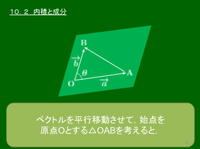高校数学[総目次]
数学B 第1章 ベクトル
| スライド | ノート | 問題 | |
| 1. ベクトルと有向線分 | [無料] | ||
| 2. ベクトルの演算 | [無料] | ||
| 3. ベクトルの成分 | [無料] | ||
| 4. ベクトルの内積 | [会員] | ||
| 5. 位置ベクトル | [会員] | ||
| 6. ベクトル方程式 | [会員] | ||
| 7. 平面ベクトルの応用 | [会員] | ||
| 8. 空間ベクトル | [会員] | ||
| 9. 空間ベクトルの成分 | [会員] | ||
| 10. 空間ベクトルの内積 | [会員] | ||
| 11. 空間の位置ベクトル | [会員] | ||
| 12. 空間ベクトルの応用 | [会員] | ||
| 13. 空間のベクトル方程式 | [会員] | [会員] |

10. 空間ベクトルの内積
10.1 空間ベクトルの内積
空間内の→0でない2つのベクトル→(a, →bのなす角をθとすると,→(a⋅→b=|→(a||→b|cosθ (0∘≦θ≦180∘)
補足
→(a=→0,または→b=→0のとき,→(a⋅→b=0と定義する.

10.2 内積と成分
→(a=(a1, a2, a3), →(b=(b1, b2, b3) のとき,
[1] →(a⋅→(b=a1b1+a2b2+a3b3
[2] →(a≠→0,→(b≠→(0 のとき,→(a と →(b のなす角を θ とすると, cosθ=→(a⋅→(b|→(a||→(b|=a1b1+a2b2+a3b3√a12+a22+a32√b12+b22+b32
[1]の証明

余弦定理により,
AB2= OA2+ OB2−2 OA⋅OB cosθ
∴|→(b−→(a|2=|→(a|2+|→(b|2−2→(a⋅→(b
∴→(a⋅→(b=|→(a|2+|→(b|2−|→(b−→(a|22 ⋯ ①
(①の右辺の分子)=(a12+a22+a32)+(b12+b22+b32)
−{(b1−a1)2+(b2−a2)2+(b3−a3)2}
=2(a1b1+a2b2+a3b3)
よって①より,
→(a⋅→(b=a1b1+a2b2+a3b3
■
例題 →a=(−1, 2, −2), →b=(2, −2, 3)の両方に垂直で,大きさが3であるベクトル→pを求めよ.
→(a,→(b の双方に垂直なベクトルの1つを →(q=(x,y,z) とすると,
→(q⊥→(a より →(q⋅→(a=0
∴−x+2y−2z=0 ⋯ ①
→(q⊥→(b より →(q⋅→(b=0
∴2x−2y+3z=0 ⋯ ②
①+② より,x+z=0 ∴x=−z ⋯ ③
①×2+② より,2y−z=0 ∴y=z2 ⋯ ④
③,④ で z=2 とおくと,→(q=(−2,1,2)
よって, →(p=±3⋅→(q|→(q|=±3⋅(−2,1,2)3=±(−2,1,2)_
補足
→(a と →(b の双方に垂直なベクトルの1つを →(q とすると,次のような計算によって →(q を求めることができる.(詳しくはスライド(会員向け)参照.)

→(q=(2⋅3−(−2)⋅(−2), (−2)⋅2−(−1)⋅3, −1⋅(−2)−2⋅2)=(2, −1, −2)
実際,
→(a⋅→(q=(−1,2,−2)⋅(−2,1,2)=2+2−4=0→(b⋅→(q=(2,−2,3)⋅(−2,1,2)=−4−2+6=0
となるから →(a⊥→(q かつ →(b⊥→(q である.
→(q を →(a と →(b の外積またはベクトル積という.ベクトル積は,2つのベクトルから1つのベクトルが返される.一方,内積は2つのベクトルから1つの実数が返される.従って内積のことをスカラー積ともいう.

10.3 内積の性質
[1] →(a⋅→b=→b⋅→(a (交換法則)[2] →a⋅→a=|→a|2[3] →(a⋅(→b+→(c)=→(a⋅→b+→(a⋅→(c (分配法則)[4] (→(a+→b)⋅→(c=→(a⋅→(c+→b⋅→(c (分配法則)[5] (k→(a)⋅→b=→a⋅(k→b)=k(→(a⋅→b) (k は実数)
補足
平面ベクトルの内積の性質と完全に同一である.

このページで疑問は解決されましたか?
こちら から数学に関するご質問・ご要望をお寄せください。
高校数学[総目次]
数学B 第1章 ベクトル
| スライド | ノート | 問題 | |
| 1. ベクトルと有向線分 | [無料] | ||
| 2. ベクトルの演算 | [無料] | ||
| 3. ベクトルの成分 | [無料] | ||
| 4. ベクトルの内積 | [会員] | ||
| 5. 位置ベクトル | [会員] | ||
| 6. ベクトル方程式 | [会員] | ||
| 7. 平面ベクトルの応用 | [会員] | ||
| 8. 空間ベクトル | [会員] | ||
| 9. 空間ベクトルの成分 | [会員] | ||
| 10. 空間ベクトルの内積 | [会員] | ||
| 11. 空間の位置ベクトル | [会員] | ||
| 12. 空間ベクトルの応用 | [会員] | ||
| 13. 空間のベクトル方程式 | [会員] | [会員] |

